Wasserdichte Wanderschuhe sind für Outdoor-Fans zu einer unverzichtbaren Ausrüstung geworden, da sie Komfort, Schutz und Haltbarkeit bei unterschiedlichen Wetterbedingungen bieten. Da Outdoor-Aktivitäten immer beliebter werden, steigt auch die Nachfrage nach hochwertigen wasserdichten Wanderschuhen. Dieser Artikel gibt einen Überblick über den Markt und beleuchtet die wachsende Nachfrage, die wichtigsten Akteure und die regionalen Trends in der Branche für wasserdichte Wanderschuhe.
Table of Contents:
Marktübersicht für wasserdichte Wanderschuhe
Innovative Materialien und Design
Leistung und Haltbarkeit
Komfort- und Sicherheitsmerkmale
Zielgruppe und Personalisierung
Marktübersicht für wasserdichte Wanderschuhe
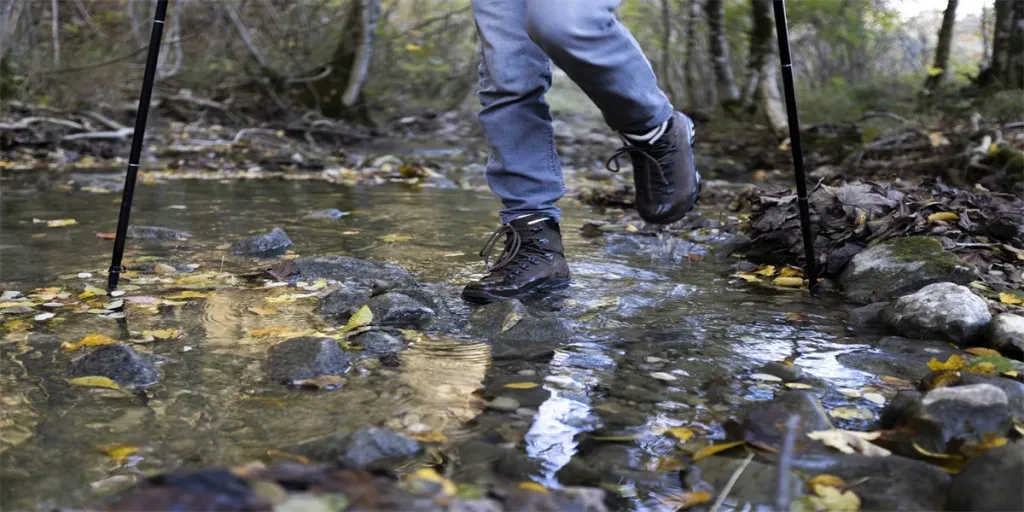
Steigende Nachfrage nach Outdoor-Aktivitäten
Die Nachfrage nach wasserdichten Wanderschuhen ist eng mit der zunehmenden Beliebtheit von Outdoor-Aktivitäten wie Wandern, Trekking und Trailrunning verbunden. Laut einem Bericht von Research and Markets wird der Markt für Wander- und Trailrunningschuhe von 6.17 bis 2023 voraussichtlich um 2028 Milliarden USD wachsen, mit einer durchschnittlichen jährlichen Wachstumsrate (CAGR) von 8.18 %. Dieses Wachstum wird durch die zunehmende Bedeutung von Wandern und Trailrunning als beliebte Freizeitaktivitäten sowie die zunehmende Premiumisierung von Wander- und Trailrunningschuhen vorangetrieben.
Wichtige Akteure und Marken auf dem Markt
Der Markt für wasserdichte Wanderschuhe ist hart umkämpft, wobei mehrere wichtige Akteure die Branche dominieren. Laut einem Bericht von Research and Markets gehören zu den führenden Anbietern auf dem Markt für Wander- und Trailschuhe Adidas AG, Columbia Sportswear Co., Deckers Outdoor Corp., KEEN Inc., La Sportiva Spa, Nike Inc., PUMA SE, Skechers USA Inc., Tecnica Group SpA, Under Armour Inc. und VF Corp.
Diese Unternehmen entwickeln ihr Produktangebot ständig weiter und verbessern es, um den sich wandelnden Bedürfnissen der Verbraucher gerecht zu werden. Adidas und Nike beispielsweise konzentrieren sich auf die Integration fortschrittlicher Technologien und Materialien, um die Leistung und den Komfort ihrer Wanderschuhe zu verbessern. Columbia Sportswear Co. und KEEN Inc. sind für ihr Engagement für Nachhaltigkeit bekannt und verwenden in ihren Produkten umweltfreundliche Materialien und Herstellungsverfahren.
Regionale Markttrends und Präferenzen
Die Nachfrage nach wasserdichten Wanderschuhen variiert in verschiedenen Regionen und wird von Faktoren wie Klima, Gelände und kulturellen Vorlieben beeinflusst. Laut einem Bericht von Research and Markets ist der Markt für Wander- und Trailschuhe in mehrere geografische Regionen unterteilt, darunter Europa, Nordamerika, Asien-Pazifik (APAC), Südamerika sowie der Nahe Osten und Afrika.
In Nordamerika wird der Markt durch die Popularität von Outdoor-Freizeitaktivitäten und das Vorhandensein von gut ausgebauten Wanderwegen und Nationalparks angetrieben. Insbesondere die Vereinigten Staaten haben eine große Verbraucherbasis, die hochwertige und langlebige Wanderschuhe schätzt. Auch in Europa gibt es einen starken Markt für wasserdichte Wanderschuhe, wobei Länder wie Deutschland, Frankreich und das Vereinigte Königreich die Nachfrage anführen. Die abwechslungsreichen Landschaften und das günstige Klima der Region für Outdoor-Aktivitäten tragen zur wachsenden Popularität von Wandern und Trekking bei.
Der asiatisch-pazifische Raum erlebt ein rasantes Wachstum im Markt für Wander- und Trekkingschuhe, das durch steigende verfügbare Einkommen, Urbanisierung und ein wachsendes Interesse an Outdoor-Aktivitäten angetrieben wird. Länder wie China und Indien erleben einen Anstieg der Nachfrage nach wasserdichten Wanderschuhen, da immer mehr Menschen Wandern und Trekking als beliebte Freizeitbeschäftigungen betrachten. Die vielfältigen Gelände der Region, die von Bergen bis zu Wäldern reichen, erzeugen eine starke Nachfrage nach leistungsstarken und langlebigen Wanderschuhen.
In Südamerika wird der Markt von den üppigen Naturlandschaften der Region und der wachsenden Popularität des Abenteuertourismus beeinflusst. Länder wie Brasilien und Argentinien verzeichnen eine steigende Nachfrage nach wasserdichten Wanderschuhen, da immer mehr Menschen die vielfältigen Outdoor-Ziele der Region erkunden. Auch der Nahe Osten und Afrika bieten Wachstumschancen, da ein steigendes Interesse an Outdoor-Aktivitäten und Abenteuertourismus die Nachfrage nach hochwertigen Wanderschuhen antreibt.
Innovative Materialien und Design
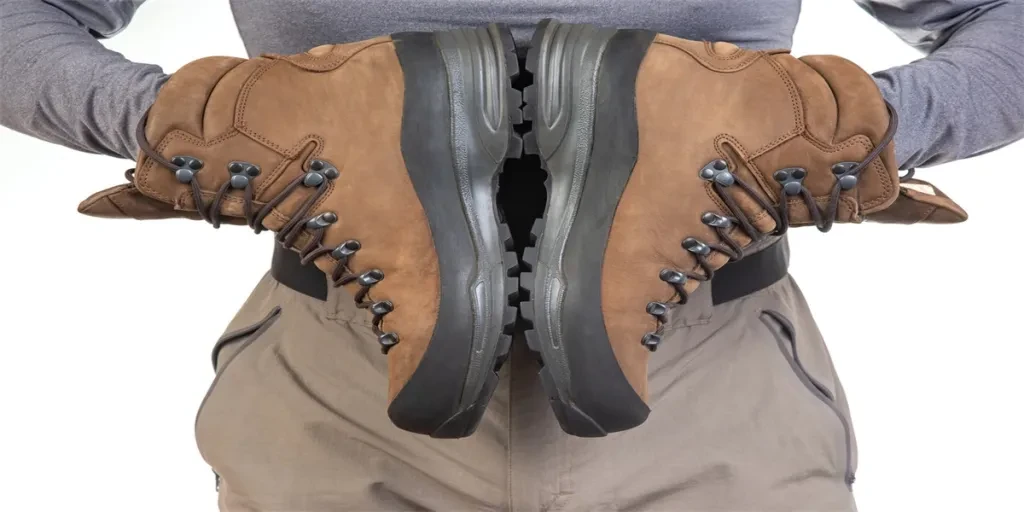
Fortschrittliche wasserdichte Technologien
Wasserdichte Wanderschuhe haben in den letzten Jahren erhebliche Fortschritte gemacht, insbesondere im Bereich der wasserdichten Technologien. Gore-Tex ist nach wie vor ein führender Name in der Branche und bekannt für seine zuverlässigen wasserdichten und atmungsaktiven Membranen. Diese Membranen sind so konzipiert, dass sie Wasser abhalten und gleichzeitig Feuchtigkeit aus Schweiß entweichen lassen, sodass die Füße auch bei Nässe trocken bleiben. Laut einem professionellen Bericht haben Gore-Tex-Modelle unter verschiedenen Bedingungen durchweg gute Leistungen erbracht, darunter bei Bachüberquerungen, überraschenden Regenfällen und Schneewanderungen zu Beginn der Saison.
Neben Gore-Tex haben viele Marken ihre eigenen wasserdichten Technologien entwickelt. So soll die Futurelight-Membran von The North Face und die B-Dry-Technologie von Oboz einen ähnlichen Grad an Wasserdichtigkeit bieten. Diese Technologien sind besonders nützlich für Wanderer, die unvorhersehbarem Wetter ausgesetzt sind oder durch nasses Gelände wandern. Es ist jedoch wichtig zu beachten, dass wasserdichte Membranen zwar einen hervorragenden Schutz vor Wasser bieten, aber auch Gewicht hinzufügen und die Atmungsaktivität verringern können, was für manche Wanderer ein Nachteil sein kann.
Nachhaltige und umweltfreundliche Materialien
Der Trend zur Nachhaltigkeit hat auch das Design und die Materialien wasserdichter Wanderschuhe beeinflusst. Viele Hersteller verwenden mittlerweile umweltfreundliche Materialien in ihren Produkten. Einige Marken verwenden beispielsweise recycelte Materialien für die oberen Teile der Schuhe, während andere nachhaltiges Leder verwenden, das in umweltfreundlichen Verfahren gegerbt wird. Dieser Wandel reduziert nicht nur die Umweltauswirkungen der Produktion, sondern spricht auch die wachsende Zahl umweltbewusster Verbraucher an.
Darüber hinaus geht die Verwendung nachhaltiger Materialien nicht auf Kosten der Leistung der Stiefel. Diese Materialien sind oft genauso langlebig und effektiv wie ihre traditionellen Gegenstücke. So können recyceltes Polyester und nachhaltiges Leder beispielsweise den gleichen Schutz und die gleiche Haltbarkeit bieten wie herkömmliche Materialien, was sie zu einer brauchbaren Option für Hochleistungs-Wanderstiefel macht.
Ergonomisches und stilvolles Design
Moderne wasserdichte Wanderschuhe sind nicht nur funktional, sondern auch stilvoll und ergonomisch. Marken konzentrieren sich zunehmend auf Designs, die sowohl Komfort als auch Ästhetik bieten. Ergonomische Designs sorgen dafür, dass die Schuhe ausreichend Halt und Dämpfung bieten, wodurch das Verletzungsrisiko verringert und der allgemeine Komfort bei langen Wanderungen erhöht wird. Merkmale wie konturierte Fußbetten, gepolsterte Kragen und verstellbare Schnürsysteme tragen zu einer besseren Passform und verbessertem Komfort bei.
Was den Stil angeht, sind Wanderschuhe mittlerweile in einer Vielzahl von Farben und Designs erhältlich, die unterschiedlichen Geschmäckern und Vorlieben gerecht werden. Diese Kombination aus Funktionalität und Stil macht wasserdichte Wanderschuhe sowohl für Outdoor-Abenteuer als auch für die Freizeit geeignet und macht sie somit für ein breiteres Publikum attraktiv.
Leistung und Haltbarkeit
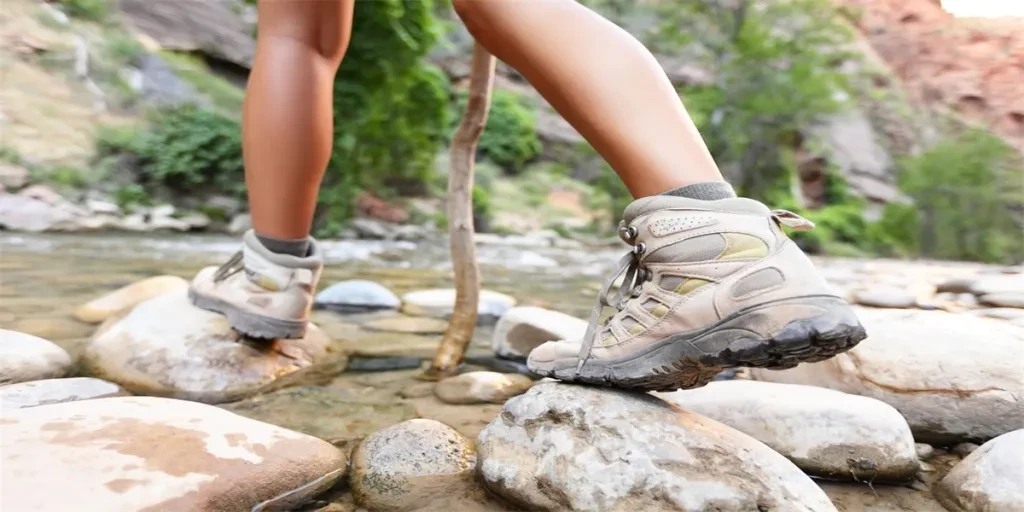
Langlebige Konstruktion
Die Haltbarkeit wasserdichter Wanderschuhe ist für viele Wanderer ein entscheidender Faktor. Die hochwertige Konstruktion stellt sicher, dass die Schuhe den Strapazen unterschiedlicher Gelände und Wetterbedingungen standhalten. Laut einem Bericht sind Schuhe wie der Adidas Terrex Swift R3 für ihre robusten und langlebigen Materialien bekannt. Diese Schuhe verfügen über robuste Laufsohlen, die auf unterschiedlichen Oberflächen hervorragenden Halt bieten, und ihre Oberteile sind so konzipiert, dass sie Abrieb und Verschleiß widerstehen.
Die Verwendung von strapazierfähigen Materialien wie Leder und hochwertigen synthetischen Stoffen trägt zur Langlebigkeit der Stiefel bei. Insbesondere Leder wird für seine Haltbarkeit und seine Fähigkeit geschätzt, sich im Laufe der Zeit an die Form des Fußes anzupassen und so eine individuelle Passform zu gewährleisten. Es ist jedoch etwas schwerer als synthetische Materialien, was für diejenigen, die leichtes Schuhwerk bevorzugen, eine Überlegung sein kann.
Wetterbeständigkeit und Anpassungsfähigkeit
Die Wetterbeständigkeit ist ein weiterer entscheidender Aspekt der Leistung wasserdichter Wanderschuhe. Diese Stiefel sind so konzipiert, dass sie die Füße vor verschiedenen Wetterbedingungen wie Regen, Schnee und Schlamm schützen. Die in diesen Stiefeln verwendeten wasserdichten Membranen sorgen dafür, dass kein Wasser ins Innere eindringt, sodass die Füße trocken und bequem bleiben.
Darüber hinaus sind viele wasserdichte Wanderschuhe so konzipiert, dass sie sich an verschiedenes Gelände anpassen. Der Adidas Terrex Swift R3 beispielsweise verfügt über eine mäßig steife Konstruktion, die auf technischem Gelände und beim Tragen schwerer Lasten Stabilität bietet. Dank dieser Anpassungsfähigkeit eignen sich diese Schuhe für eine breite Palette von Wanderaktivitäten, von Tageswanderungen bis hin zu mehrtägigen Rucksacktouren.
Feldtests und Benutzerbewertungen
Feldtests und Benutzerbewertungen spielen eine wichtige Rolle bei der Bewertung der Leistung und Haltbarkeit wasserdichter Wanderschuhe. Viele Marken führen umfangreiche Feldtests durch, um sicherzustellen, dass ihre Produkte den Anforderungen realer Wanderbedingungen gerecht werden. Benutzerbewertungen bieten außerdem wertvolle Einblicke in die praktische Leistung der Schuhe und zeigen ihre Stärken und potenziellen Verbesserungsbereiche auf.
In Benutzerbewertungen des Adidas Terrex Swift R3 wird beispielsweise häufig dessen Stabilität und Schutz gelobt, während andere Benutzer anmerken, dass die Stiefel steif und für schnelle Wanderungen weniger bequem sein können. Diese Bewertungen helfen den Herstellern, ihre Designs zu verfeinern und etwaige Probleme zu beheben, was letztendlich zu besseren Produkten für die Verbraucher führt.
Komfort- und Sicherheitsmerkmale
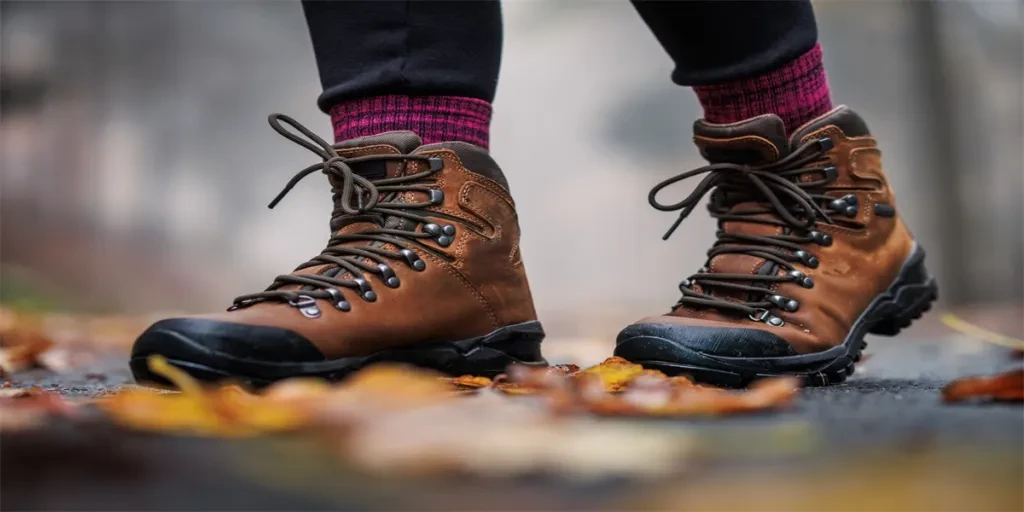
Dämpfungs- und Stützsysteme
Komfort ist ein wichtiger Aspekt bei jedem Wanderschuh, und wasserdichte Modelle bilden da keine Ausnahme. Fortschrittliche Dämpfungs- und Stützsysteme sind unerlässlich, um Ermüdungserscheinungen vorzubeugen und Verletzungen bei langen Wanderungen vorzubeugen. Viele wasserdichte Wanderschuhe verfügen über gepolsterte Innen- und Zwischensohlen, die Stoßdämpfung und Halt bieten. Diese Komponenten helfen, das Gewicht gleichmäßig zu verteilen und die Belastung von Füßen und Gelenken zu verringern.
Darüber hinaus verfügen einige Stiefel über spezielle Stützsysteme wie Fußgewölbeunterstützung und Fersenkappen. Diese Eigenschaften verbessern die allgemeine Passform und den Komfort der Stiefel, sodass sie für längeres Tragen geeignet sind. Der Adidas Terrex Swift R3 beispielsweise ist mit einer stützenden Konstruktion ausgestattet, die Stabilität und Komfort auch auf anspruchsvollem Gelände bietet.
Rutschfeste Sohlen und Traktion
Sicherheit ist ein weiterer wichtiger Aspekt bei Wanderschuhen, und rutschfeste Sohlen sind unerlässlich, um Unfälle auf rutschigen oder unebenen Oberflächen zu vermeiden. Wasserdichte Wanderschuhe verfügen häufig über Laufsohlen mit aggressivem Profilmuster, die auf unterschiedlichem Gelände hervorragenden Halt bieten. Diese Sohlen sind so konzipiert, dass sie auf Oberflächen wie Schlamm, Fels und Schnee guten Halt bieten und so das Risiko von Ausrutschern und Stürzen verringern.
So ist der Adidas Terrex Swift R3 beispielsweise mit einer Außensohle ausgestattet, die auf unterschiedlichen Oberflächen guten Halt bietet, was ihn zu einer zuverlässigen Wahl für technisches Gelände macht. Die Kombination aus rutschfester Sohle und robuster Konstruktion sorgt dafür, dass Wanderer anspruchsvolle Wanderwege sicher bewältigen können.
Knöchelunterstützung und Schutz
Knöchelunterstützung ist entscheidend, um Verletzungen vorzubeugen, insbesondere auf unebenem oder felsigem Gelände. Wasserdichte Wanderschuhe sind oft hoch geschnitten, um den Knöcheln zusätzlichen Halt und Schutz zu bieten. Diese Designs helfen, den Fuß zu stabilisieren und das Risiko von Verstauchungen und anderen Verletzungen zu verringern.
Darüber hinaus verfügen viele Stiefel über gepolsterte Kragen und verstärkte Bereiche um die Knöchel für zusätzlichen Komfort und Schutz. Diese Eigenschaften sorgen dafür, dass die Stiefel einen sicheren Sitz bieten und die Knöchel vor Stößen und Abschürfungen schützen.
Zielgruppe und Personalisierung
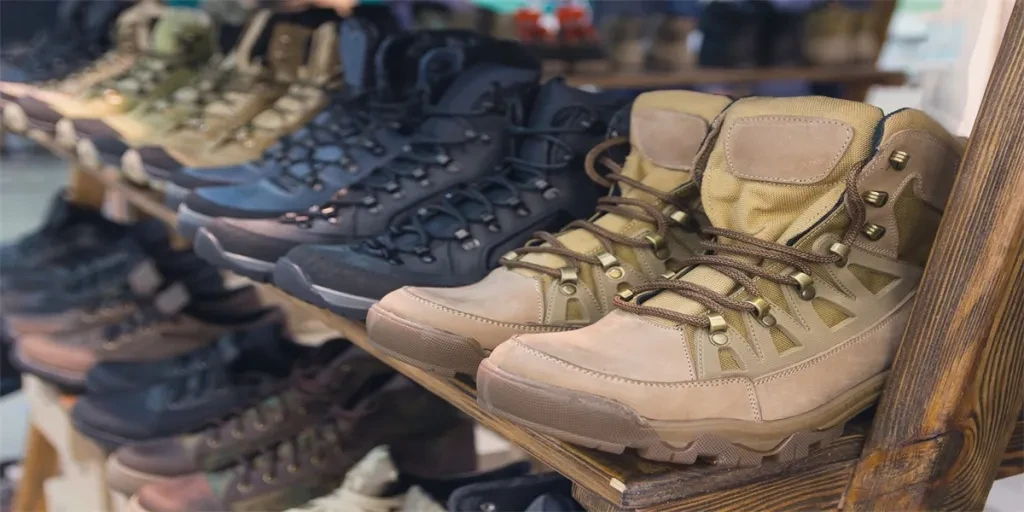
Für verschiedene Wanderniveaus geeignet
Wasserdichte Wanderschuhe sind für Wanderer aller Niveaus geeignet, vom Anfänger bis zum erfahrenen Abenteurer. Verschiedene Modelle bieten unterschiedliche Stufen an Halt, Schutz und Komfort, um den Bedürfnissen verschiedener Benutzer gerecht zu werden. Leichte Modelle mit flexibler Sohle sind beispielsweise ideal für Gelegenheitswanderer und Tagesausflüge, während robustere Modelle mit steifer Konstruktion für technisches Gelände und mehrtägige Rucksacktouren geeignet sind.
Individuelle Passform und Personalisierungsoptionen
Anpassungsoptionen werden in der Wanderschuhbranche immer beliebter. Viele Marken bieten Funktionen wie verstellbare Schnürsysteme, herausnehmbare Einlegesohlen und anpassbare Fußbetten für eine individuelle Passform. Diese Optionen ermöglichen es Wanderern, ihre Stiefel an ihre spezifischen Bedürfnisse und Vorlieben anzupassen, was den Gesamtkomfort und die Leistung verbessert.
Geschlechts- und altersspezifische Designs
Die Hersteller konzentrieren sich auch darauf, geschlechts- und altersspezifische Designs zu entwickeln, um ein vielfältiges Publikum anzusprechen. Wanderschuhe für Frauen beispielsweise haben oft schmalere Absätze und einen niedrigeren Schaft, um den anatomischen Unterschieden zwischen Männern und Frauen Rechnung zu tragen. Ebenso werden Stiefel für Kinder und ältere Erwachsene mit Merkmalen entworfen, die ihren individuellen Bedürfnissen gerecht werden, wie z. B. zusätzliche Polsterung und Halt.
Fazit
Die Entwicklung wasserdichter Wanderschuhe spiegelt eine Mischung aus fortschrittlicher Technologie, nachhaltigen Praktiken und benutzerorientiertem Design wider. Da die Branche weiterhin Innovationen hervorbringt, werden diese Schuhe vielseitiger, langlebiger und bequemer und sprechen eine breite Palette von Wanderbegeisterten an. Mit Blick auf die Zukunft wird der Fokus auf Nachhaltigkeit und Anpassung wahrscheinlich weitere Fortschritte vorantreiben und sicherstellen, dass wasserdichte Wanderschuhe für Outdoor-Abenteurer weiterhin ein Muss bleiben.





 Afrikaans
Afrikaans አማርኛ
አማርኛ العربية
العربية বাংলা
বাংলা Nederlands
Nederlands English
English Français
Français Deutsch
Deutsch हिन्दी
हिन्दी Bahasa Indonesia
Bahasa Indonesia Italiano
Italiano 日本語
日本語 한국어
한국어 Bahasa Melayu
Bahasa Melayu മലയാളം
മലയാളം پښتو
پښتو فارسی
فارسی Polski
Polski Português
Português Русский
Русский Español
Español Kiswahili
Kiswahili ไทย
ไทย Türkçe
Türkçe اردو
اردو Tiếng Việt
Tiếng Việt isiXhosa
isiXhosa Zulu
Zulu